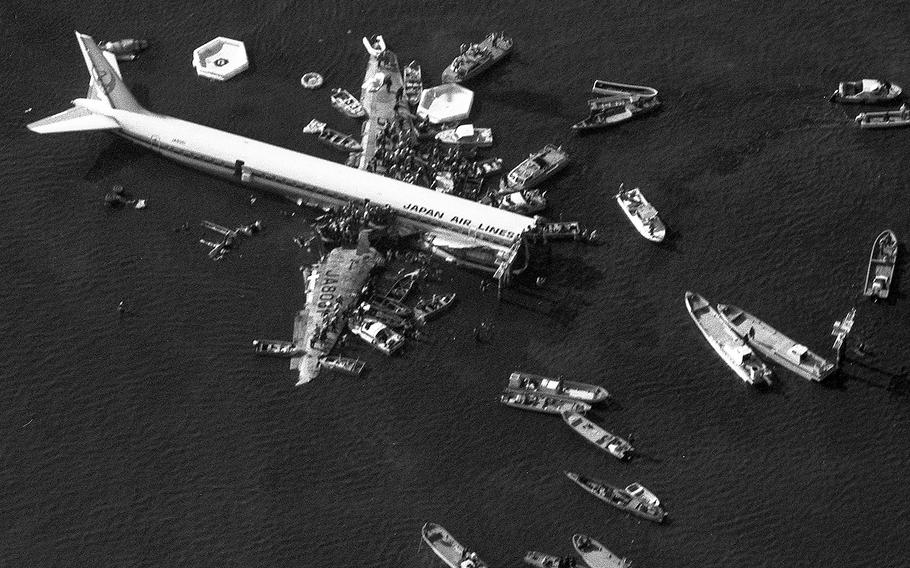
Boats surround a Japan Air Lines DC-8 that crashed in a shallow part of Tokyo Bay while landing at Haneda International Airport in February, 1982, killing 24 of the 166 passengers and crew on board as the fuselage split in two. (Stars and Stripes)
TOKYO — From the distance, about 300 yards away, the DC-8 looked like an exploded cigar. The fuselage's frame splayed like burnt, shredded tobacco leaves. Directly below, partly buried in the mud of low tide, was the nose. It was pointed toward home.
Initial reports that morning said only two persons had been killed when a Japan Air Lines jetliner plunged into Tokyo Bay on its approach to Haneda Airport.
But the death toll had risen with the sun.
"I saw three, four bodies."
"They tried a heart massage on one guy, but it obviously wasn't working."
It would be a long day in which officials and newsmen tried to quantify the unquantifiable: tragedy.
———
Hundreds of police and airport security men roped off the area at the end of the runway, where medical teams administered first-aid before the injured were loaded into ambulances. Beyond the breakwall, rescue workers and divers shoved off in boats that would bring in more people.
Earlier, the area roped off was about 30 feet square. By 10:30 it was triple that size.
———
Later, a passenger would say: "We had our seat belts fastened, but there was no time to get into the emergency landing position. I felt a shock and, just one or two seconds later, another shock. Almost immediately water came gushing into the cabin and that's when I knew what had happened."
"The plane broke right behind me," another would say. "Those people who were sitting there were crushed."
The pileup in the aisle "reminded me of a Rugby scrum, with people pushing and climbing over one another," another survivor said. No, he said, he couldn't recall when the plane went down, explaining, "I didn't think to look at my watch."
———
A policeman manning the rope line supplied an updated figure. "There are 12 dead," he said.
———
Close to shore, the water was black, the bay's natural color. Out there, under the strong mid-morning sun, the rescue workers looked as if they were frolicking waist-deep in some glistening, shelly effluent. The sky was clear, the wind negligible. Blood and death were only a look back. But out there ... what were they doing near that burned-out cigarillo?
One of the rescued walked through a puzzle of litters, clutching blankets and trailing water. The features of her face were lost in the cowl of warmth. She stepped into a large, empty bus and sat down.
———
Seventeen dead.
———
The noise of the helicopters carried inland, where it collided with instructions and warnings issuing from an official standing in the back of a truck. Lost in the din were moans and, in some cases, final words.
How many injured? No one knew.
———
The airline blankets were yellow blue, green, mostly pastels. There was an occasional red, but it was subdued, tasteful. The blankets, piled five, six high, only hinted at the form over which they were now draped.
At any one time, there were about two dozen of these rainbow-colored mounds. In one mound, under the pastel blankets, there was a twitch. It was more than a twitch, really. Perhaps it was a spasm.
Whatever it was, it was involuntary — as involuntary as dying.
———
The woman in the bus was still sitting alone. It had been 15 minutes — long enough time, say, for another person to be rescued and another one to die.
———
Before the day was over there were 24 dead.